The DirectX 12 Performance Preview: AMD, NVIDIA, & Star Swarm
by Ryan Smith on February 6, 2015 2:00 PM EST- Posted in
- GPUs
- AMD
- Microsoft
- NVIDIA
- DirectX 12
CPU Scaling
Diving into our look at DirectX 12, let’s start with what is going to be the most critical component for a benchmark like Star Swarm, the CPU scaling.
Because Star Swarm is designed to exploit the threading inefficiencies of DirectX 11, the biggest gains from switching to DirectX 12 on Star Swarm come from removing the CPU bottleneck. Under DirectX 11 the bulk of Star Swarm’s batch submission work happens under a single thread, and as a result the benchmark is effectively bottlenecked by single-threaded performance, unable to scale out with multiple CPU cores. This is one of the issues DirectX 12 sets out to resolve, with the low-level API allowing Oxide to more directly control how work is submitted, and as such better balance it over multiple CPU cores.
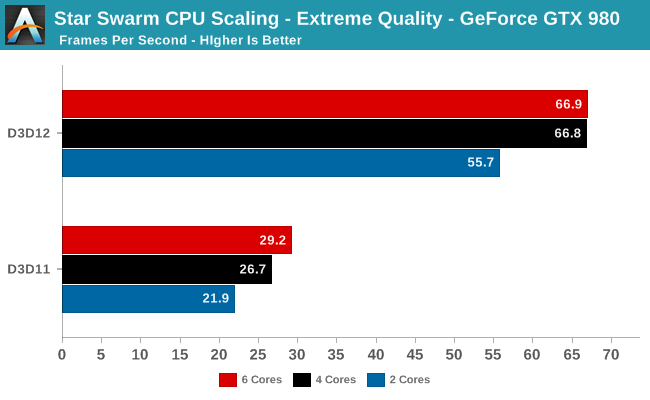
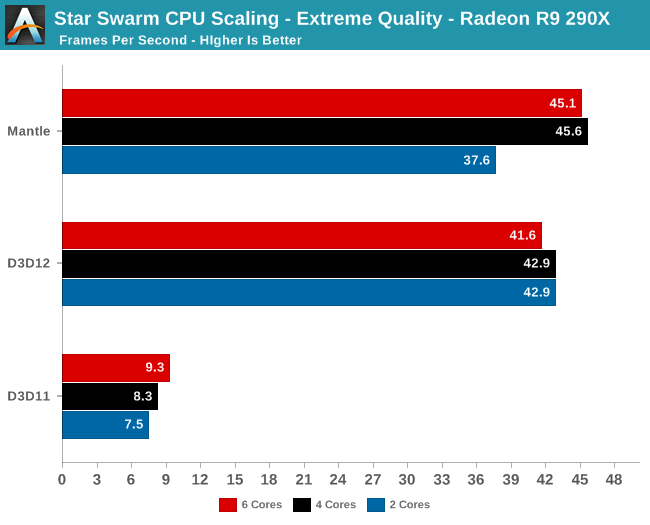
Starting with a look at CPU scaling on our fastest cards, what we find is that besides the absurd performance difference between DirectX 11 and DirectX 12, performance scales roughly as we’d expect among our CPU configurations. Star Swarm's DirectX 11 path, being single-threaded bound, scales very slightly with clockspeed and core count increases. The DirectX 12 path on the other hand scales up moderately well from 2 to 4 cores, but doesn’t scale up beyond that. This is due to the fact that at these settings, even pushing over 100K draw calls, both GPUs are solidly GPU limited. Anything more than 4 cores goes to waste as we’re no longer CPU-bound. Which means that we don’t even need a highly threaded processor to take advantage of DirectX 12’s strengths in this scenario, as even a 4 core processor provides plenty of kick.
Meanwhile this setup also highlights the fact that under DirectX 11, there is a massive difference in performance between AMD and NVIDIA. In both cases we are completely CPU bound, with AMD’s drivers only able to deliver 1/3rd the performance of NVIDIA’s. Given that this is the original Mantle benchmark I’m not sure we should read into the DirectX 11 situation too much since AMD has little incentive to optimize for this game, but there is clearly a massive difference in CPU efficiency under DirectX 11 in this case.
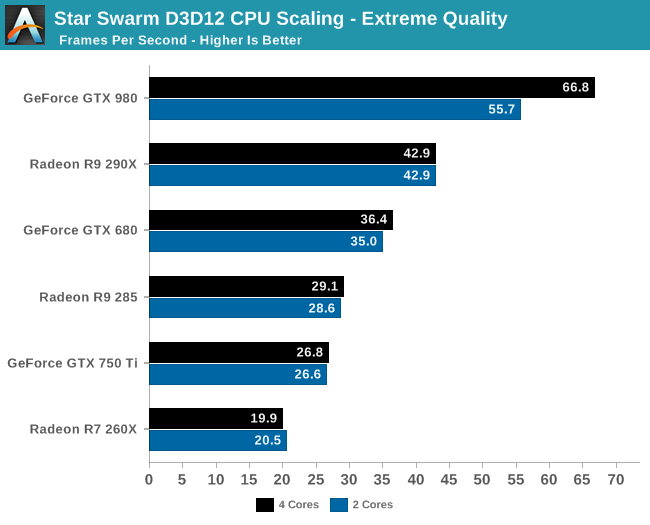
Having effectively ruled out the need for 6 core CPUs for Star Swarm, let’s take a look at a breakdown across all of our cards for performance with 2 and 4 cores. What we find is that Star Swarm and DirectX 12 are so efficient that only our most powerful card, the GTX 980, finds itself CPU-bound with just 2 cores. For the AMD cards and other NVIDIA cards we can get GPU bound with the equivalent of an Intel Core i3 processor, showcasing just how effective DirectX 12’s improved batch submission process can be. In fact it’s so efficient that Oxide is running both batch submission and a complete AI simulation over just 2 cores.
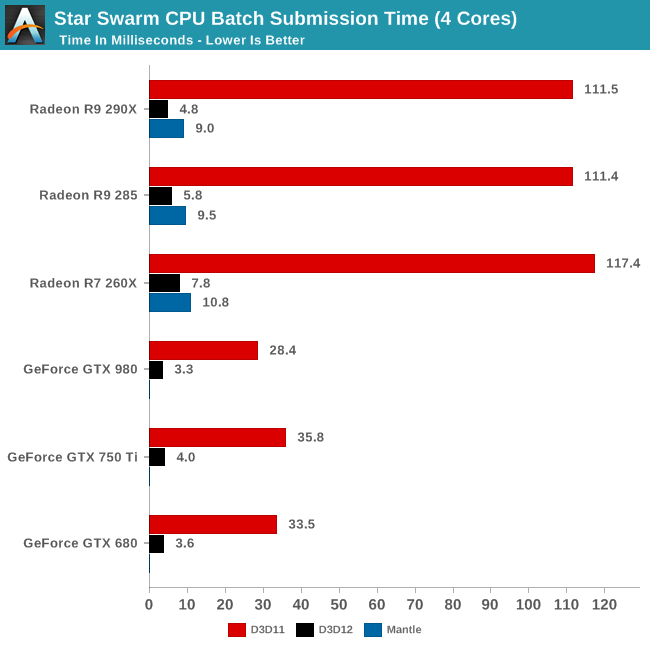
Speaking of batch submission, if we look at Star Swarm’s statistics we can find out just what’s going on with batch submission. The results are nothing short of incredible, particularly in the case of AMD. Batch submission time is down from dozens of milliseconds or more to just 3-5ms for our fastest cards, an improvement just overof a whole order of magnitude. For all practical purposes the need to spend CPU time to submit batches has been eliminated entirely, with upwards of 120K draw calls being submitted in a handful of milliseconds. It is this optimization that is at the core of Star Swarm’s DirectX 12 performance improvements, and going forward it could potentially benefit many other games as well.
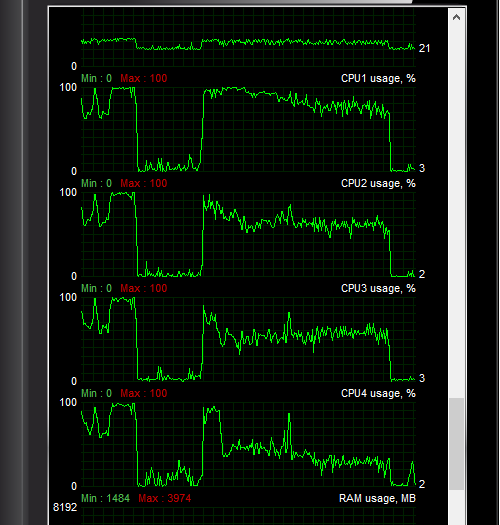
Another metric we can look at is actual CPU usage as reported by the OS, as shown above. In this case CPU usage more or less perfectly matches our earlier expectations: with DirectX 11 both the GTX 980 and R9 290X show very uneven usage with 1-2 cores doing the bulk of the work, whereas with DirectX 12 CPU usage is spread out evenly over all 4 CPU cores.
At the risk of speaking to the point that it’s redundant, what we’re seeing here is exactly why Mantle, DirectX 12, OpenGL Next, and other low-level APIs have been created. With single-threaded performance struggling to increase while GPUs continue to improve by leaps and bounds with each generation, something must be done to allow games to better spread out their rendering & submission workloads over multiple cores. The solution to that problem is to eliminate the abstraction and let the developers do it themselves through APIs like DirectX 12.










245 Comments
View All Comments
OrphanageExplosion - Sunday, February 8, 2015 - link
On a tiny minority of titles.bloodypulp - Sunday, February 8, 2015 - link
Battlefield 4Battlefield Hardline
Thief
Star Citizen
Plants vs. Zombies: Garden Warfare
Civilization: Beyond Earth
Dragon Age: Inquisition
Mirror's Edge 2
Sniper Elite 3
... and growing every day.
bloodypulp - Sunday, February 8, 2015 - link
Who needs to wait for DX12? Mantle is running great for me right now. :)sireangelus - Sunday, February 8, 2015 - link
would you do one quick test using an 8core fx?johnny_boy - Sunday, February 8, 2015 - link
Would have loved to see this, and some lower end CPUs even.editorsorgtfo - Sunday, February 8, 2015 - link
What about threaded CPUs ? for example 1 core 2 threads old pentium CPUs and 2 cores 4 threads i3 CPUs ? can you still count that them as 2 cores and 4 cores ?
I wanna ask this on the anandtech comment section but I don't have an account there XD
boe - Sunday, February 8, 2015 - link
What I care about are great graphics. It is a shame there is no Crytek 4 engine to show off what DX12 could do. MS should have hired the original crytek developers to create some showpiece game.Gigaplex - Monday, February 9, 2015 - link
The API won't really change what you can do compared to DX11 other than reduce some system requirements. The feature levels are what provides new eye candy, and this preview doesn't cover that aspect. Wait until it hits retail, you'll probably see some fancy tech demos.Thermalzeal - Sunday, February 8, 2015 - link
I have one big question to ask.Since Direct X12 is resulting in significant performance gains, what is the potential for these improvements to translate over to the Xbox One? While I'm sure the Xbox One already has some of these bare metal improvements, due to the focus of the device...is it possible that DX12 will make the Xbox One more powerful than the PS4?
Ryan Smith - Sunday, February 8, 2015 - link
"Since Direct X12 is resulting in significant performance gains, what is the potential for these improvements to translate over to the Xbox One?"Only Microsoft really knows the answer to that one. But I would be shocked beyond belief if the XB1's D3D 11.X API didn't already implement many of these optimizations. It is after all a fixed console, where low-level APIs have been a mainstay since day one.
"is it possible that DX12 will make the Xbox One more powerful than the PS4?"
In a word, no. The best case scenario for Microsoft is that Sony implements their own low-level API (if they haven't already) and we're back at square one. APIs can't make up for hardware differences when both parties have the means and influence to create what would be similar APIs.